

EXPLORE BY TOPIC:
  Our top 10 resources
Our top 10 resources
  Childhood / Early Life
Childhood / Early Life
  Chronic Stress
Chronic Stress
  Education
Education
  Food Security
Food Security
  Genetics
Genetics
  Jobs & Work
Jobs & Work
  Housing / Neighborhoods
Housing / Neighborhoods
  Income & Wealth
Income & Wealth
  Race / Racism
Race / Racism
  Social Inclusion
Social Inclusion
  Policy & Change
Policy & Change





Buy the DVD
e-Newsletter
FAQs
Contact Us
Site Map
Home

|
 |


|
Background: Perhaps the biggest predictor of one's health is one's wealth. It's not just the poor who are suffering; every step down the class pyramid corresponds to worse health. Study after study has shown that those at the top of the class pyramid live on average longer, healthier lives than the rest of us. The middle classes fare worse than those on the top, and the poor get sick more often and die sooner.
The greater the inequality in a society, the steeper the gradient. Currently, the United States has the greatest inequality among rich countries - and the worst health inequities. People in the middle are twice as likely to die prematurely (before age 65) as those on top; people at the bottom are three times as likely.
The life expectancy of American men in the highest income group is 8 years longer than for men in the lowest income group, two and a half years longer than for the second highest income group. Wealthy women live almost 7 years longer than poor women. Children in low-income families are seven times as likely to be in poor or fair health as those in high-income families. Poorer adults are three times as likely to have a chronic disease that limits their activity; twice as likely to have diabetes, and are nearly 50% as likely to die of heart disease.
Wealth doesn't just bring more material comfort, it also provides financial security and access to resources that promote opportunities for better health. Higher income affects health at every age, from the beginning of life to adulthood and old age. For adults, wealth is tied to neighborhood quality, work conditions, food security, access to medical care, and the availability of buffers against stress.
For children, the impact of advantages or disadvantages is even greater, because the effect on health is cumulative. The greater proportion of life one spends at the upper end of the class spectrum, the more benefits accrue. Children from affluent families are more likely to grow up in a house owned by their parents and to live in a neighborhood with healthy food options, safe places to play, good schools, libraries and other quality public services – all of which help set them on the path to a successful, healthy life.
Children from less affluent families not only lack these advantages, they are more likely to experience conditions that limit their health and ultimately their life chances: injuries, inadequate or delayed health care, physical inactivity, poor nutrition, insecure or substandard housing, and exposure to toxins, high lead levels and violence. The influence of wealth on health begins even before a child is born, shaping the quality of prenatal care an expectant woman receives, her level of stress during pregnancy and her likelihood of delivering a premature or low birth weight baby.
Wealth is an important determinant of health because it has such a profound effect on other conditions. Yet at every socioeconomic level, African Americans, Native Americans and other people of color fare worse than their white counterparts. Racism as a stress factor independent of class partially explains this, but racism – for example, in the form of residential segregation or job discrimination – also directly affects wealth.
Today, the wealth gap in America is growing. The average CEO makes more than 250 times the average worker’s salary, and the top 1% of American households holds more wealth than the bottom 90% combined. In the last 25 years, the income of top earners has increased 81%, while wages for those on the low end of the pay scale have stagnated or declined.
Our health has followed suit. In 1980, the U.S. ranked 14th in the world for life expectancy. In 2007 we ranked 29th. One out of every five American children lives in poverty. Many of the countries that rank higher than we do have policies that protect workers, support families, and provide a safety net for their citizens. These policies typically address income and wealth inequality in one of two ways: (1) they reduce the overall gap so that everyone has sufficient resources to prosper and maintain control over their lives or (2) they loosen the connection between health and wealth by making certain resources available to everyone, not dependent on a family's individual assets.
Examples of policies to reduce the gap include a guaranteed living wage, earned income tax credits, family supports, guaranteed paid vacation and sick leave, secure pensions, and severance pay and job training for unemployed workers. Examples of policies to loosen the wealth-health relationship include universal preschool, better land use and zoning policies, school financing reform, universal health insurance, and stronger environmental protections and better enforcement.

|
|
|
| |
|
Income & Wealth: 0 items found |
 Profile of four individuals: Mapping health and inequities across Louisville Profile of four individuals: Mapping health and inequities across Louisville 
MAP and CHARTS based on UNNATURAL CAUSES |
 |
 Promoting Health Equity: A Resource to Help Communities Address Social Determinants of Health (pdf) Promoting Health Equity: A Resource to Help Communities Address Social Determinants of Health (pdf) 
WORKBOOK - Centers for Disease Control and Prevention, 2008 This workbook is for community-based organizations seeking to affect the social determinants of health through community-based participatory approaches and nontraditional partnerships. Along with an introduction to the concepts of health equity, the workbook presents case studies of communities working at both small and large scales. The authors then provide guidelines for developing your own initiative, from creating partnerships to identifying your approach to assessing and maintaining your progress. |
 |
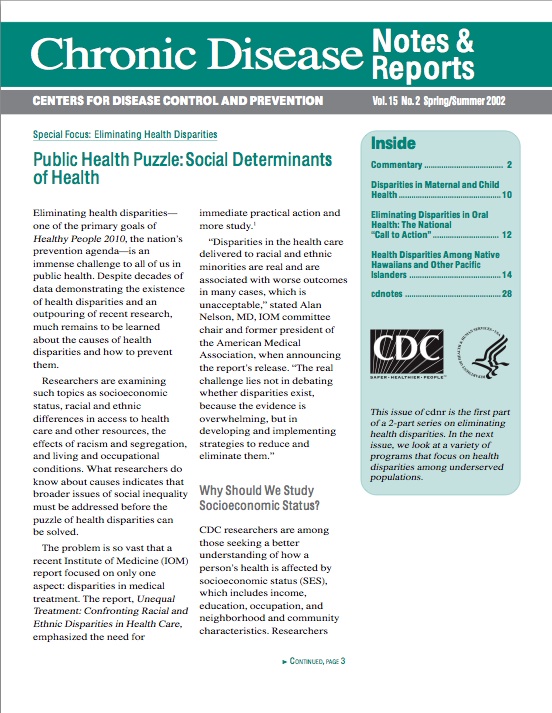 Public Health Puzzle: Social Determinants of Health (pdf) Public Health Puzzle: Social Determinants of Health (pdf) 
NEWSLETTER, Chronic Disease Notes & Reports, Centers for Disease Control and Prevention This issue of cdnr is the first part of a 2-part series on eliminating health disparities. It includes articles on disparities in maternal and child health, eliminating disparities in oral health, and health disparities among Native Hawaiians and other Pacific Islanders. |
 |
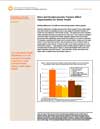 Race and Socioeconomic Factors Affect Opportunities for Better Health (pdf) Race and Socioeconomic Factors Affect Opportunities for Better Health (pdf) 
REPORT by the RWJF Commission to Build a Healthier America, April 2009 This issue brief provides evidence and explanations for striking differences health status by both race and socioeconomic status. |
 |
 Racial Residential Segregation: A Fundamental Cause of Racial Disparities in Health (pdf) Racial Residential Segregation: A Fundamental Cause of Racial Disparities in Health (pdf) 
SCHOLARLY ARTICLE by David R. Williams and Chiquita Collins, Public Health Reports, 2001 The authors review evidence that suggests that segregation is a primary cause of racial differences in socioeconomic status (SES) by determining access to education and employment opportunities. SES in turn remains a fundamental cause of racial differences in health. Segregation also creates conditions inimical to health in the social and physical environment. The authors conclude that effective efforts to eliminate racial disparities in health must seriously confront segregation and its pervasive consequences |
 |
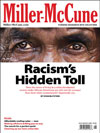 Racism's Hidden Toll Racism's Hidden Toll 
MAGAZINE ARTICLE, Miller McCune, June 2009 In profiling researcher Arline Geronimus and the development of her weathering hypothesis, this article lays out evidence for the relevance of racism and other social factors for understanding population health, particularly in the example of teen pregnancies in low-income Black communities. Could serve as an introduction to the topic for those new to health equity ideas. |
 |
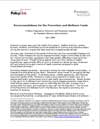 Recommendations for the Prevention and Wellness Funds (pdf) Recommendations for the Prevention and Wellness Funds (pdf) 
POLICY MEMO from PolicyLink and Prevention Institute, April 2009 This memo offers recommendations for targeting Prevention and Wellness recovery funds to maximize the health and equity benefits in the Recovery Act of spring 2009. It makes the case that prioritizing disease prevention – particularly among the most impacted communities – is imperative to strengthening the nation. It makes specific recommendations for using funds to
- Build upon and leverage existing prevention initiatives;
- Promote equity by targeting America’s low-income communities and communities of color;
- Target multi-disciplinary strategies focused on environmental change;
- Develop the health workforce to effectively shape and implement prevention efforts; and
- Advance a vision of healthy people, healthy places. |
 |
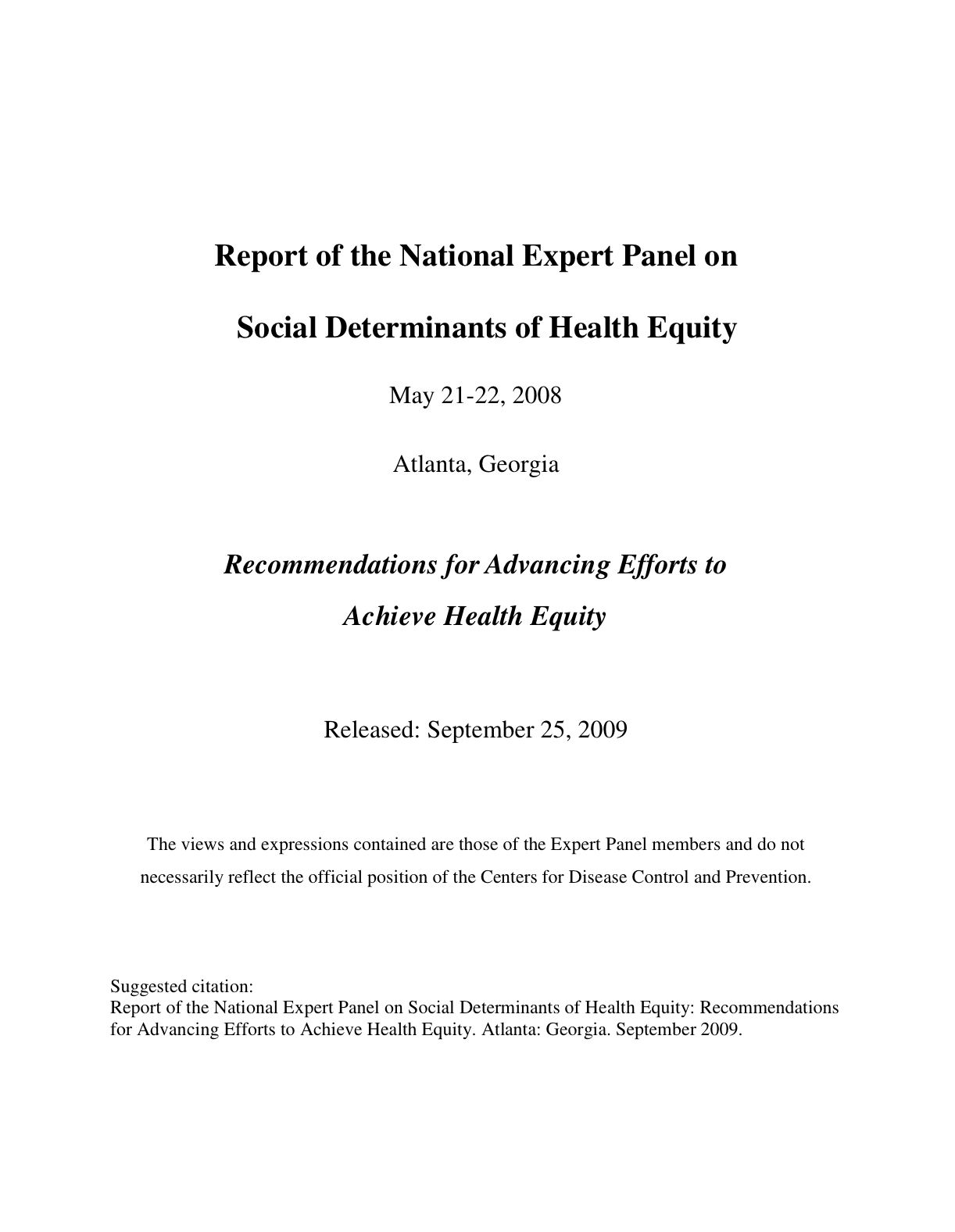 Report of the National Expert Panel on Social Determinants of Health Equity: Recommendations for Advancing Efforts to Achieve Health Equity Report of the National Expert Panel on Social Determinants of Health Equity: Recommendations for Advancing Efforts to Achieve Health Equity 
This report encapsulates the critical thinking, key arguments and recommendations of nationally recognized experts in the area of social determinants of health equity. A principle thesis of the Expert Panel is that the inequitable distribution of resources needed for health is the major contributor to persistent health inequities. These experts called to account conditions and processes, including class disadvantage and racism, that prevent many Americans from enjoying the health and long life that affluent and privileged citizens take for granted. Many of the strategies for addressing social determinants of health equity fall outside current public health practice but not outside the profession’s historic role in public policy decisions that promote social justice. |
 |
 Research: Green areas lower health inequities between rich, poor Research: Green areas lower health inequities between rich, poor 
NEWS ARTICLE, USA Today, Nov 11, 2008 Health inequalities between rich and poor people are much lower in areas that have lots of green space, such as parks, forests and playing fields, a large British study finds. |
 |
rising Inequality, Declining Health: Health Outcomes and the Working Poor 
How healthy are people who are working but still can’t make ends meet? How does their health compare to those who are working and have good incomes? How do both of those health outcomes compare to those who are poor and not working? This report shows a widening gap between the health of people who are living in poverty and working and those whose work provides sufficient incomes. This suggests that worsening labour market conditions, a weakened social safety net and increasing income inequality are accompanied by rising inequities in health. |
 |
 Sick People or Sick Societies? Sick People or Sick Societies? 
RADIO SHOW, CBC, "The Best of Ideas Podcast" 2008 Journalist Jill Eisen explores the importance of the social determinants of health from a Canadian perspective. The program devotes considers the importance of looking at "upstream" causes of health and presents possible policies for intervention on different levels.
Part One: S. Leonard Syme, Richard Glazier, Carol Shively, and Michael Marmot explain the concepts behind social determinants of health, present evidence for how stress contribute to "modern" diseases, and elaborate the moral and practical obligations we have to demand action. Part Two: Dennis Raphael, Richard Glazier, and Clyde Hertzman discuss the obesity and diabetes epidemics and early childhood development. Raphael makes an interesting commentary as to why governments continuously fail to address social threats to health. |
 |
 Sir Michael Marmot Interview (mp3) Sir Michael Marmot Interview (mp3) 
PODCAST, Web-exclusive content from UNNATURAL CAUSES In this audio podcast, excerpted from an interview conducted during the making of UNNATURAL CAUSES, Sir Michael Marmot of University College, London, discusses the social gradient in health, his pioneering Whitehall Studies and why he's optimistic about improving health outcomes.
ENHANCED PODCAST (m4a) |
 |
 Sir Michael Marmot Interview (pdf) Sir Michael Marmot Interview (pdf) 
EDITED INTERVIEW TRANSCRIPT, UNNATURAL CAUSES In an original interview, Michael Marmot discusses how he got into public health issues, then addresses a wide range of issues, from the healthy immigrant effect to social gradients in smoking to why the wealthy should care about health inequities... and what we can do about them. |
 |
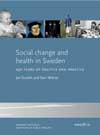 Social change and health in Sweden - 250 years of politics and practice Social change and health in Sweden - 250 years of politics and practice 
BOOK by Jan Sundin and Sam Willner, Swedish National Institute of Public Health, 2008 This thorough text examines the history of public health in Sweden, with particular attention to the emergence of the welfare state in the past century. Say the authors, "Historical lessons cannot be transferred uncritically from one country to another. However, differences and similarities in appropriate contexts can increase our understanding of relations between health and society. We hope that this book will be useful for policy comparisons and in the training of public health policy-makers, researchers, administrators and practitioners."
Full pdf available online, 5 MB. |
 |
 Social Exclusion Knowledge Network Social Exclusion Knowledge Network 
WEB SITE by the WHO Commission on the Social Determinants of Health This Knowledge Network (KN) examines the relational processes that lead to the exclusion of particular groups of people from engaging fully in community/social life. These processes may operate at: the macro-level (access to affordable education, equal employment opportunity legislation, cultural and gender norms), and/or the micro-levels (income, occupational status, social networks - around race, gender, religion). The network also examines the linkages between social exclusion and proximal concepts such as social capital, networks and integration. |
 |
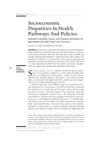 Socioeconomic Disparities In Health: Pathways and Policies Socioeconomic Disparities In Health: Pathways and Policies 
SCHOLARLY ARTICLE by Nancy E. Adler and Katherine Newman, Health Affairs, 2002 Socioeconomic status (SES) underlies three major determinants of health: health care, environmental exposure, and health behavior. In addition, chronic stress associated with lower SES may also increase morbidity and mortality. Reducing SES disparities in health will require policy initiatives addressing the components of socioeconomic status (income, education, and occupation) as well as the pathways by which these affect health. Lessons for U.S. policy approaches are taken from the Acheson Commission in England, which was charged with reducing health disparities in that country. |
 |
 Staying Alive: Critical Perspectives on Health, Illness, and Health Care Staying Alive: Critical Perspectives on Health, Illness, and Health Care 
BOOK by Dennis Raphael, Toba Bryant, and Marcia Rioux, 2006 In addition to the traditional approaches of health sciences and the sociology of health, this contributed volume shows the impact that human rights issues and political economy have on health, and takes up these issues as they occur in Canada and the United States within a wider international context. The book also contains chapters on issues of pharmaceutical policy, social exclusion, gender and care, the social construction of illness and disability, and approaches to promoting population health that include insights into the impact of economic forces such as globalization and privatization on health care and other health issues. |
 |
 Strategic Actions for a Just Economy Strategic Actions for a Just Economy 
WEB SITE SAJE is an economic justice, community development, and popular education center that has been building economic power for working class people in Los Angeles since 1996. Over the past eleven years, SAJE's winning combination of community organizing, coalition-building, and grassroots policy has gained significant benefits for the community. Accomplishments include creating the nation's first welfare-to-work bank account and, through the Figueroa Corridor Coalition for Economic Justice, negotiating the nation's most comprehensive community benefits agreement. |
 |
 Strategic Alliance for Healthy Food and Activity Environments Strategic Alliance for Healthy Food and Activity Environments 
WEB SITE The Strategic Alliance is a coalition of nutrition and physical activity advocates in California, working to shift the debate on nutrition and physical activity away from a primary focus on personal responsibility and individual choice to one that examines corporate and government practices and the role of the environment in shaping eating and activity behaviors. The Alliance's goal is to benefit the health and wellness of all California residents by promoting environmental solutions and institutional and government policies and practices that support healthy eating and activity. |
 |
 Strategic Review of Health Inequalities in England Post 2010 Strategic Review of Health Inequalities in England Post 2010 
WEB SITE Professor Sir Michael Marmot has been asked by the British government to Chair an independent Review to propose the most effective strategies for reducing health inequalities in England from 2010. This review is a response to the recommendation of the WHO Commission on Social Determinants of Health that national governments develop and implement strategies and policies suited to their particular national context aimed at improving health equity. |
 |
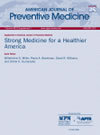 Strong Medicine for a Healthier America Strong Medicine for a Healthier America 
American Journal of Preventive Medicine A supplement to the latest issue of the American Journal of Preventive Medicine (AJPM), funded by the Robert Wood Johnson Foundation, includes six articles and a broad array of commentaries that provide a fundamental understanding of the fact that where, we live, learn, work and play has as much to do with our health as the health care we receive.
The authors–including Risa Lavizzo-Mourey, David R. Williams, Michael G. Marmot and more–address factors beginning with early childhood education, to homes and communities, to the economic rationale for improving the lives of disadvantaged Americans. Together, the collection provides an in-depth look at why some Americans are so much healthier than others and why Americans are not the healthiest people in the world. |
 |
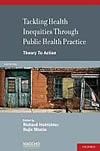 Tackling Health Inequities Through Public Health Practice: Theory to Action Tackling Health Inequities Through Public Health Practice: Theory to Action 
BOOK edited by Richard Hofrichter and Rajiv Bhatia
Social justice has always been a core value driving public health. Today, much of the etiology of avoidable disease is rooted in inequitable social conditions brought on by disparities in wealth and power and reproduced through ongoing forms of oppression, exploitation, and marginalization.
Tackling Health Inequities raises questions and provides a starting point for health practitioners ready to reorient public health practice to address the fundamental causes of health inequities. This reorientation involves restructuring the organization, culture and daily work of public health. Tackling Health Inequities is meant to inspire readers to imagine or envision public health practice and their role in ways that question contemporary thinking and assumptions, as emerging trends, social conditions, and policies generate increasing inequities in health. |
 |
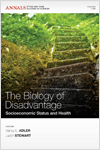 The Biology of Disadvantage: Socioeconomic Status and Health The Biology of Disadvantage: Socioeconomic Status and Health 
JOURNAL Nancy E. Adler and Judith Stewart, eds. Annals of the New York Academy of Science How does socioeconomic status get under the skin? This book summarizes the decade of research by the MacArthur Foundation Research Network on Socioeconomic Status and Health “exploring the pathways and mechanisms that contribute to the gradient relationship between socioeconomic status and health.”
PDFs of each article are available online. You may also purchase a complete copy of the journal.
|
 |
 The Fall and Rise of US Inequities in Premature Mortality: 1960-2002. The Fall and Rise of US Inequities in Premature Mortality: 1960-2002. 
SCHOLARLY ARTICLE by Nancy Krieger, et al., PLoS Medicine, 2008 Between 1966 and 1980, socioeconomic inequities in premature mortality and infant death shrank, absolutely and relatively, especially for US populations of color. However, starting in 1980, the relative gaps widened and the absolute gaps remained unchanged. |
 |
 The Need to Combine Social and Health Policy The Need to Combine Social and Health Policy 
EDITORIAL by Madeline Drexler, Boston Globe, November 18, 2008 In this short piece, journalist Drexler makes a case for the incoming president to make a serious commitment to improving national health by looking beyond health care to policies that shape employment, housing, transportation, agriculture, taxation, and other social issues. |
 |
| « Prev 1 | 2 | 3 | 4 | 5 | 6 | 7 Next » |
|




